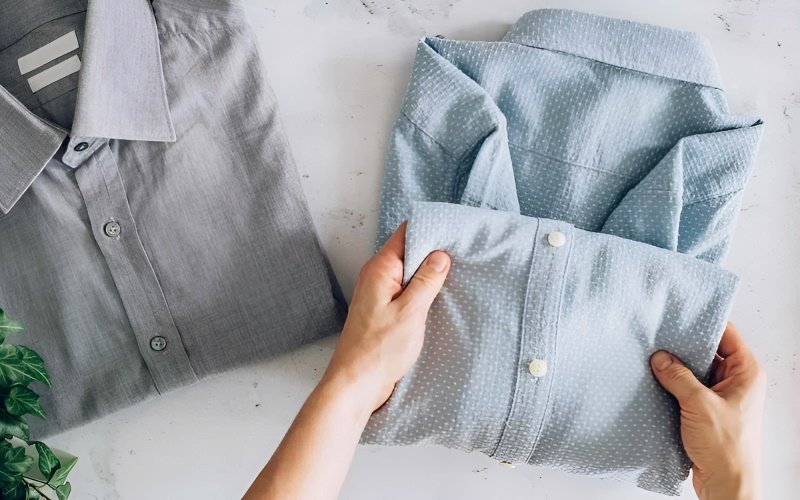Long-Term Clothes Storage: Garment Preservation Guide
Is your closet overflowing with clothes you love but rarely wear? Perhaps you’re switching out your seasonal wardrobe, or maybe you have cherished garments you want to preserve for years to come. Whatever the reason, proper long-term clothes storage is crucial.
Neglecting this can lead to damaged fabrics, unwanted pests, and a wardrobe full of regrets. This article will provide you with a comprehensive, step-by-step guide to storing your clothes correctly, ensuring they remain in pristine condition until you’re ready to wear them again.
You’ll discover the secrets to assessing your wardrobe, preparing your garments, choosing the right storage solutions, and maintaining an ideal storage environment. By following these expert tips, you can confidently protect your clothing investment and enjoy your favorite pieces for many seasons.
1. Assessing your clothes: What to store and what to let go
Before you even think about packing, take a good, hard look at your wardrobe. It’s tempting to keep everything, but smart storage starts with smart decisions. Begin by emptying your closet and sorting your clothes into distinct piles. This process, often called wardrobe management or seasonal wardrobe rotation, helps with clothing organization. But beyond just organizing, the real objective here is to identify which items truly deserve a spot in long-term storage, and which ones might be better off finding a new home. The aim is to keep only what adds value to your wardrobe in the long run, and address any damaged items before they go into storage.
- Examine each garment: Is it in good condition? Does it still fit? Have you worn it in the last year?
- Consider the fabric: Is this something that will store well? Check for potential damage: will it be susceptible to moth holes or mildew stains?
- Be honest with yourself: Do you realistically see yourself wearing this item again?
1.1 The keep, sell, donate, repurpose method
A straightforward way to streamline your wardrobe. This approach can dramatically reduce clutter and makes the storage process far more manageable.
Keep: These are the items you love, wear regularly (or will wear when the season is right), and that fit well. These clothes are your wardrobe staples and any pieces with significant sentimental value.
Sell: If you have gently used, high-quality items that you no longer wear, consider selling them.
Donate: Clothes that are still in good condition but don’t fit your style or needs anymore can be donated.
Repurpose: For items that are too worn to donate or sell, consider repurposing.

1.2 Identifying damage and repair needs
Before storing anything, it’s crucial to assess the condition of your clothes. Even minor damage can worsen over time in storage. Textile conservation is not just for museums; it starts in your own closet.
Start by laying each garment flat on a well-lit surface. Thoroughly examine the item, inside and out. Turn sleeves inside out, check pockets, and inspect seams. You’re looking for any signs of:
- Fabric Damage: Look for tears, snags, or thinning fabric.
- Moth Holes: These are tiny, irregular holes often found in wool, silk, or other natural fibers.
- Mildew Stains: These appear as discolored patches, often with a musty odor.
- Other Stains: Check for any other spots or discoloration, even if they seem minor.
If you find damage, decide whether it’s something you can repair yourself or if it requires professional attention. Small tears or loose seams can often be easily mended.
2. Preparing your clothes for long-term storage
Once you’ve decided which clothes to store, proper preparation is key to preserving them. Think of it as laying the foundation for successful long-term garment preservation. This involves more than just folding and packing; it’s about creating an environment that minimizes the risks of damage from pests, moisture, and general wear and tear, even while in storage. Meticulous preparation is a proactive approach to textile care, increasing the likelihood that your clothes will emerge from storage in excellent condition.
2.1 The importance of cleaning before storage
This might seem obvious, but it’s a step that’s often overlooked, and its importance cannot be overstated. Cleaning clothes before long-term storage is essential for several reasons:
Removing Stains and Odors: Food stains, even seemingly invisible ones, can oxidize over time, becoming more difficult to remove and potentially attracting pests. Body oils, sweat, and perfumes can also degrade fabric fibers and cause yellowing or discoloration.
Preventing Pest Infestations: Moths and other insects are attracted to food residues and body oils. Clean clothes are far less likely to become a target.
Minimizing Mildew Growth: Any lingering moisture, combined with organic matter (like skin cells or food particles), creates an ideal breeding ground for mildew, especially in dark, enclosed storage spaces.
Always check the care label for specific washing instructions. Different fabric types require different cleaning methods. Some items might need to be hand-washed or dry-cleaned. Pay close attention to removing all traces of dirt, body oils, and any food spills.
2.2 To iron or not to iron?
This is a common question, and the answer isn’t always straightforward. There are valid arguments on both sides when it comes to ironing clothes before long-term storage.
Arguments for Ironing: Ironing can kill any remaining insect eggs or larvae that might be present on the fabric. It also creates a smooth surface, which can minimize creasing during storage.
Arguments Against Ironing: Ironing, especially at high temperatures, can weaken some fabric fibers. Over time, the sharp creases created by ironing can become permanent, particularly in natural fibers like linen or cotton.
If you choose to iron, use a low heat setting and avoid starch, which can attract pests. For delicate fabrics, it’s often best to skip ironing altogether. A good alternative is to gently steam the garment to remove wrinkles without the risk of scorching or creating sharp creases. Ultimately, prioritize gentle handling and avoid anything that could potentially stress the fabric.
3. Choosing the right storage containers and materials
Selecting the appropriate storage containers and materials is just as crucial as cleaning and preparing your clothes. The right choices will protect your garments from dust, pests, light, and moisture, while the wrong ones can actually contribute to damage. This section offers a comprehensive look at various options, empowering you to make informed decisions based on your specific needs and the types of clothing you’re storing.
3.1 Breathable vs. non-breathable: Understanding the options
This is a fundamental distinction in the world of clothing storage. Each type has its advantages and disadvantages, and the best choice depends largely on the type of fabric and the storage environment.
Breathable Containers: These are made of materials that allow air to circulate, such as cotton, linen, or canvas.
- Examples: Garment bags made of cotton or canvas, fabric storage boxes, and even old pillowcases.
- Benefits: Excellent for natural fibers like wool, silk, linen, and cotton. Allows moisture to escape, preventing mildew and musty odors. Reduces the risk of fabric yellowing.
- Drawbacks: May not offer as much protection against pests as non-breathable options.
Non-Breathable Containers: These are made of materials that create a barrier against air and moisture, such as plastic.
- Examples: Plastic bins with lids, under-bed storage containers, and vacuum-sealed bags.
- Benefits: Provide excellent protection against pests, dust, and moisture. Can be a good choice for synthetic fabrics.
- Drawbacks: Can trap moisture, leading to mildew and musty odors if clothes aren’t completely dry. Not ideal for natural fibers, which need to breathe.
It’s crucial that plastic containers are thoroughly cleaned and dried before use.
3.2 Essential storage supplies
Beyond the containers themselves, several supporting materials can significantly enhance the preservation of your stored clothes. These supplies address specific threats, such as pests, moisture, and acid migration.
Acid-Free Tissue Paper: This is a must-have for delicate fabrics, vintage items, and anything you want to protect from yellowing or discoloration. It’s used to wrap individual items or to create a buffer between layers of clothing. The “acid-free” aspect is crucial; regular tissue paper can contain acids that damage fabric over time.
Cedar: A natural moth repellent. Cedar blocks, chips, or hangers release a pleasant aroma that deters moths and other insects.
Moth Repellent (Alternatives to Cedar): Lavender sachets, rosemary, thyme, and other herbal repellents offer a gentler scent while still providing some protection against pests.
Moisture Absorbers: Essential for humid environments. These products, such as silica gel packets or desiccant containers, absorb excess moisture from the air, preventing mildew and musty odors.
Silica Gel: Small packets that absorb moisture. Ideal for placing inside storage containers, especially plastic bins.
Consider: It’s always best to use preventive measures against moths and insects, especially for natural fabrics like cotton, wool, and silk.
4. Mastering the art of packing clothes for storage
Now that you’ve prepared your clothes and chosen your storage solutions, it’s time to pack. Proper packing techniques are essential for maximizing space, preventing wrinkles, and protecting your garments from damage during long-term storage. This isn’t just about throwing clothes into a box; it’s about carefully arranging and protecting each item to ensure it stays in the best possible condition.
4.1 Folding techniques for different fabrics
Different fabrics require different folding methods to minimize wrinkles and prevent damage. The goal is to avoid sharp creases and excessive pressure, which can weaken fibers over time.
General Principles:
- Smooth Out Wrinkles: Before folding, smooth out any existing wrinkles by hand.
- Avoid Over-Folding: Don’t fold garments too many times, as this can create stress points.
- Loose Folds: Opt for loose, gentle folds rather than tight, sharp ones.
Specific Fabric Types:
- Shirts and Blouses: Button up shirts and blouses completely. Fold the sleeves inward towards the center back, then fold the shirt in half or thirds, depending on the storage space.
- Pants and Skirts: Fold pants along the creases, then fold in half or thirds. Skirts can be folded in half lengthwise, then rolled or folded loosely.
- Sweaters and Knitwear: These are best folded loosely or rolled to avoid stretching. Avoid hanging sweaters, as this can distort their shape.
- Silk and Lace: These delicate fabrics should be handled with extra care. Place acid-free tissue paper between folds to prevent snagging and minimize wrinkles.
- Coats and Jackets: For bulky items like coats and jackets, fold them as little as possible. Fold the sleeves inward, then fold the coat in half.
Rolling vs. Folding: Rolling can be a great space-saving technique, especially for items like t-shirts, jeans, and some knitwear. However, it’s not ideal for all fabrics. Delicate items or those prone to wrinkling are usually better off folded.

4.2 Hanging clothes: When and how
While folding is suitable for many items, some garments benefit from being hung, even in long-term storage. Hanging helps maintain the shape of structured items and prevents wrinkles in delicate fabrics.
When to Hang:
- Structured Items: Garments with defined shoulders, such as suits, blazers, and coats, should be hung to preserve their shape.
- Delicate Dresses: Dresses made of silk, lace, or other delicate fabrics are best hung to prevent wrinkles and snagging.
- Items Prone to Wrinkling: If you have space, hanging any item that wrinkles easily can be beneficial.
How to Hang:
- Use Padded Hangers: These provide support and prevent sharp creases in the shoulders. Avoid wire hangers, which can distort fabric and cause rust stains.
- Use Garment Bags: Protect hanging clothes with breathable garment bags made of cotton or canvas. These keep out dust and pests while allowing air to circulate.
- Don’t Overcrowd: Allow enough space between hanging garments to prevent crushing and allow for air circulation.
4.3 Layering and protecting clothes within containers
When packing clothes in boxes or bins, proper layering is key to preventing damage and maximizing space.
Heavier Items on the Bottom: Place heavier items, such as jeans, sweaters, or folded coats, at the bottom of the container.
Lighter Items on Top: Place lighter, more delicate items on top to avoid crushing them.
Use Acid-Free Tissue Paper: Place sheets of acid-free tissue paper between layers of clothing to prevent color transfer, reduce friction, and minimize wrinkles. This is especially important for delicate fabrics and items with embellishments.
Fill Empty Spaces: Use tissue paper or clean, soft fabric scraps to fill any empty spaces in the container. This prevents items from shifting during transport and storage.

4.4 A word on vacuum sealing
Vacuum sealing can be tempting for its space-saving capabilities, but it’s not always the best choice for long-term clothing storage.
Benefits: Vacuum sealing significantly reduces the volume of clothing, making it ideal for short-term storage or travel. It also provides excellent protection against dust, pests, and moisture.
Risks: Prolonged compression can damage delicate fabrics, particularly natural fibers like wool, silk, and down. It can also cause permanent creases and wrinkles.
Recommendations:
- Short-Term Storage Only: If you use vacuum sealing, it’s best for short-term storage (a few months at most).
- Bulky Items: Vacuum sealing can be suitable for bulky items like comforters or winter coats, but avoid using it for delicate or easily damaged fabrics.
- Natural Fibers: Generally, avoid vacuum sealing natural fibers. If you must, ensure the items are completely dry and use the lowest possible suction setting.
5. Creating the ideal storage environment
Even with perfect packing, the storage environment itself plays a critical role in preserving your clothes. Temperature, humidity, light, and pests can all wreak havoc on fabrics over time. Creating a stable, controlled environment is essential for preventing damage and ensuring your clothes remain in pristine condition.
5.1 Temperature and humidity control: The key to preservation
Fluctuations in temperature and humidity are major threats to stored clothing. Understanding the science behind these factors is crucial for effective preservation.
Ideal Temperature: A cool, consistent temperature is best. Aim for a range of 65-75°F (18-24°C). Avoid extreme heat, which can accelerate fabric degradation and cause colors to fade.
Ideal Humidity: The ideal relative humidity for clothing storage is between 40% and 50%. High humidity encourages mold and mildew growth, while low humidity can cause fabrics to become brittle.
The Science Behind It:
- High Humidity: Excess moisture in the air provides a breeding ground for mold and mildew, which can stain and damage fabrics. It can also cause metal components (like zippers and buttons) to corrode.
- Low Humidity: Extremely dry air can draw moisture out of natural fibers, making them brittle and prone to breakage.
- Temperature Fluctuations: Frequent changes in temperature can cause fibers to expand and contract, weakening them over time.
Monitoring: Use a hygrometer to monitor temperature and humidity levels in your storage area.
5.2 Choosing the right location: Attic, basement, closet, or storage unit?
Each potential storage location has its own set of pros and cons. A careful evaluation is necessary to determine the best option for your needs.
Attic:
- Pros: Often offers ample space.
- Cons: Prone to extreme temperature fluctuations (hot in summer, cold in winter). Can be dusty and susceptible to pests.
- Challenges: Requires significant effort to control temperature and humidity.
- Solutions: May require insulation and ventilation improvements. Use of a dehumidifier or air conditioner may be necessary.

Basement:
- Pros: Typically cooler than other parts of the house.
- Cons: High humidity is a major concern. Risk of flooding. Can be damp and musty.
- Challenges: Requires careful moisture control.
- Solutions: Use a dehumidifier. Ensure proper drainage and waterproofing. Store items off the floor.
Closet:
- Pros: Convenient and readily accessible. Usually has a more stable temperature and humidity than attics or basements.
- Cons: Limited space. May not be suitable for large quantities of clothing.
- Challenges: Ensure good air circulation within the closet.
Storage Unit:
- Pros: Offers a dedicated space for storage. Climate-controlled units are available.
- Cons: Can be expensive. Requires transporting items to and from the unit.
- Challenges: Verify the unit’s climate control capabilities and security measures.
Considering a storage unit is one way to store clothes. Especially for businesses starting to develop, renting a unit outside is also an option to consider.
5.3 Protecting clothes from light and dust
Light and dust are often overlooked but significant threats to stored clothing.
Light: Prolonged exposure to light, especially direct sunlight, can cause colors to fade and fibers to weaken. This is particularly true for natural fibers and brightly colored items.
Solutions:
- Store clothes in a dark location, away from windows.
- Use opaque storage containers or garment bags.
- If storing in a closet with a window, use blackout curtains or blinds.
Dust: Dust particles can abrade fabric fibers and cause discoloration over time.
Solutions:
- Use dust covers, garment bags, or storage containers to protect clothes.
- Regularly clean the storage area to minimize dust accumulation.
- Consider using an air purifier in the storage area.
6. Maintaining your stored clothes
Proper storage isn’t a “set it and forget it” process. Ongoing maintenance is crucial to ensure your clothes remain in good condition. Regular checks and occasional refreshing can prevent minor issues from becoming major problems.
Even in the best storage environment, it’s important to periodically check on your stored clothes. Recommended Checking Schedule: Aim to check on your stored clothes every 3-6 months.
What to Look For:
- Signs of Pests: Look for any evidence of moths, rodents, or other pests, such as droppings, holes in fabric, or shed insect skins.
- Moisture Problems: Check for any signs of dampness, musty odors, or mildew growth.
- Fabric Condition: Examine the clothes for any signs of yellowing, discoloration, or damage.
- Odor: Air out the storage containers, this also helps prevent any unpleasant odors.
Refreshing:
- Airing Out Clothes: If possible, occasionally air out your stored clothes by hanging them in a well-ventilated area for a few hours. This helps to remove any stale odors and prevent mildew.
- Replacing Cedar and Moth Repellents: Cedar and other natural repellents lose their effectiveness over time. Replace them every few months, or as needed.
- Checking Moisture Absorbers: If you’re using silica gel or other moisture absorbers, check them regularly and replace or reactivate them as needed.
7. Related Questions
7.1 How often should I refold stored clothes?
Refolding isn’t strictly necessary if clothes were folded properly initially and are stored in a stable environment. However, if you notice significant creasing or shifting during your regular checks (every 3-6 months), refolding can help redistribute pressure and prevent permanent creases. This is particularly relevant for delicate fabrics or items stored in stacks.
7.2 Can I store clothes in plastic bags long-term?
Generally, it’s not recommended to store clothes in standard plastic bags (like dry-cleaning bags) for extended periods. These bags can trap moisture, leading to mildew and yellowing. They also don’t allow fabrics to breathe. However, specialized airtight plastic containers with ventilation can be suitable, provided the clothes are completely dry before storage.
7.3 What’s the best way to store vintage clothing?
Vintage clothing often requires special care due to its age and delicate fabrics. The best approach is to use acid-free tissue paper to wrap individual items, then store them flat in acid-free boxes or breathable garment bags. Avoid hanging delicate vintage pieces, as this can strain the fabric. Maintain a stable, cool, dark, and dry environment.
7.4 How to store leather clothes long-term?
Allow garments and bags (especially leather) to dry completely after cleaning. Placing in storage without fully drying can lead to mildew. Be sure to place dust covers or breathable garment bags over leather.
Read more:
Long-term clothes storage, when done correctly, is an investment in the longevity of your wardrobe. By taking the time to assess your clothes, prepare them properly, choose the right storage solutions, and create an ideal storage environment, you can protect your garments from damage and ensure they remain in excellent condition for years to come.
Remember that the key principles are cleanliness, proper packing, a stable environment, and regular maintenance. These proactive measures will not only save you money in the long run but also allow you to enjoy your favorite clothing items whenever you choose to wear them again. So, embrace these expert tips and confidently store your clothes, knowing they’ll be ready and waiting when you need them.






















